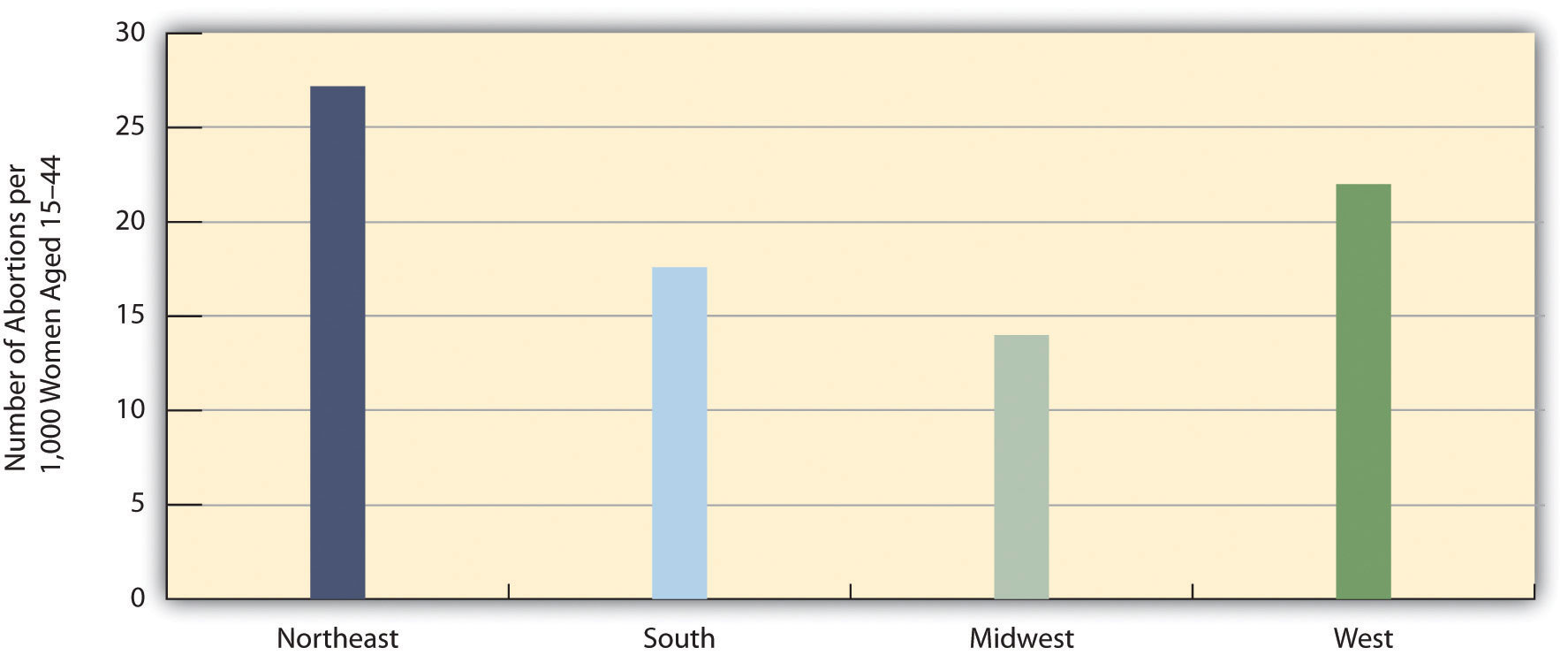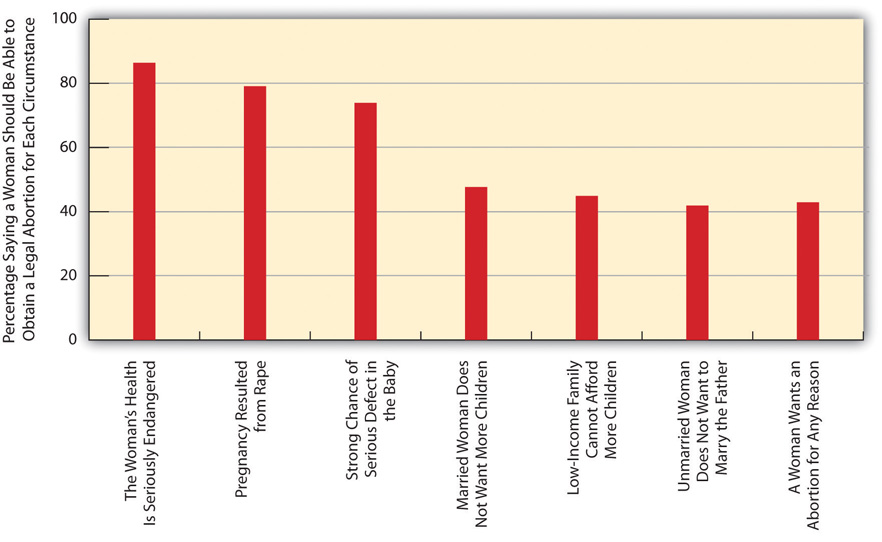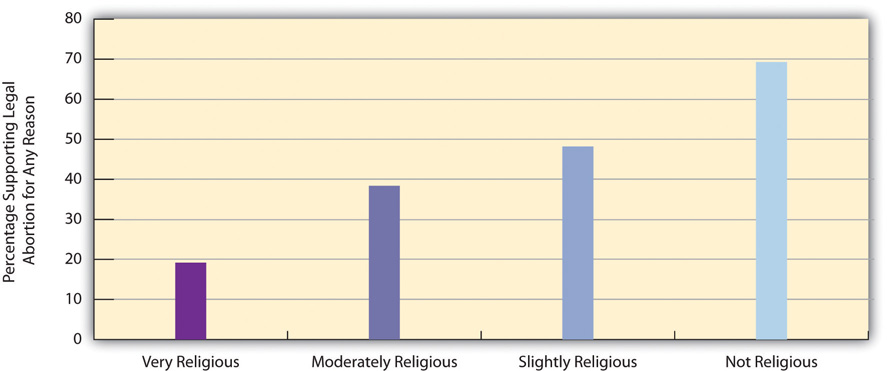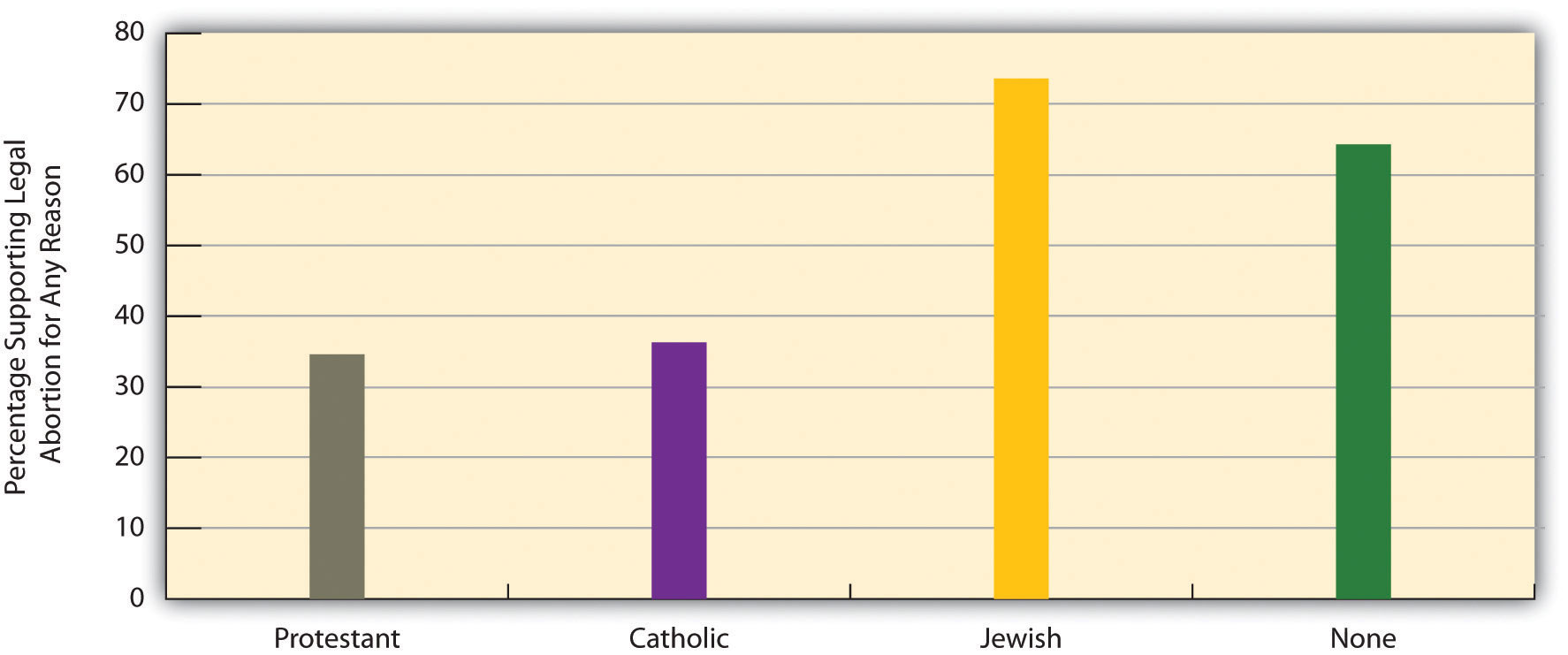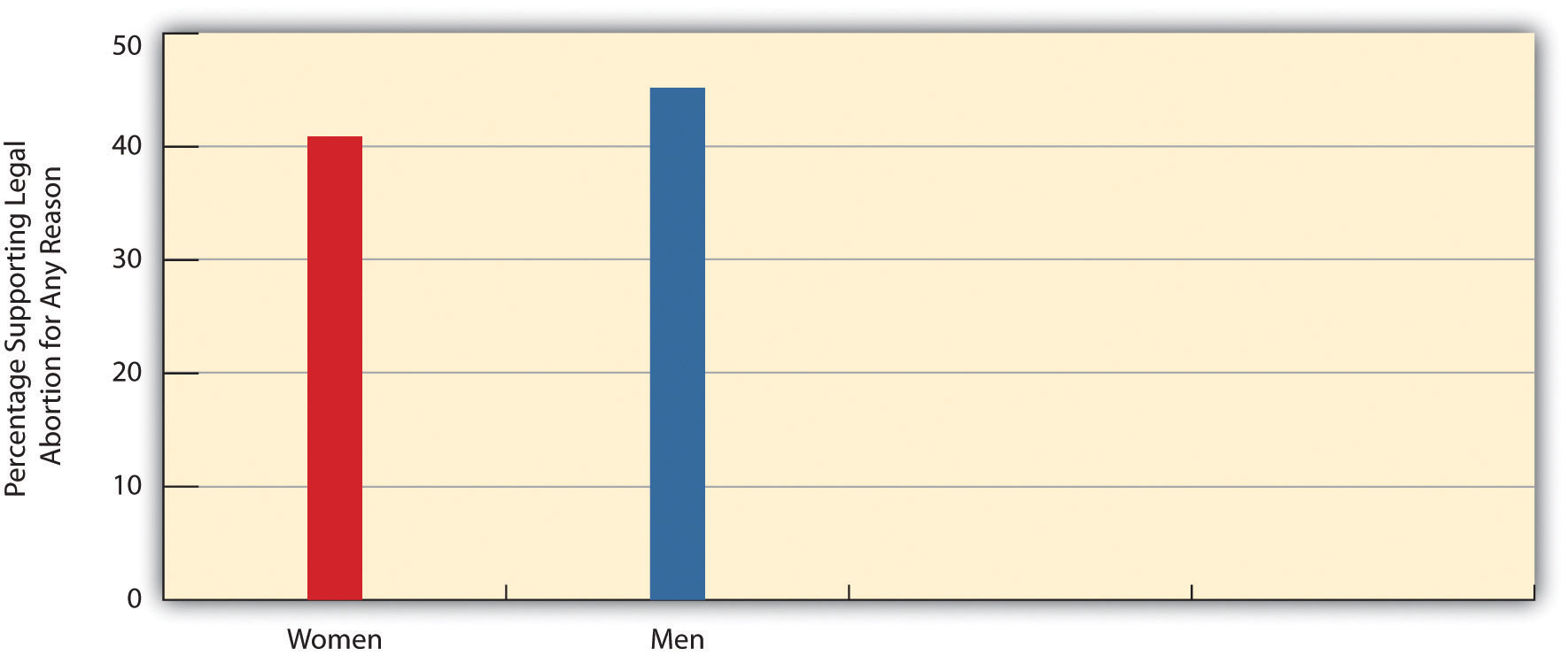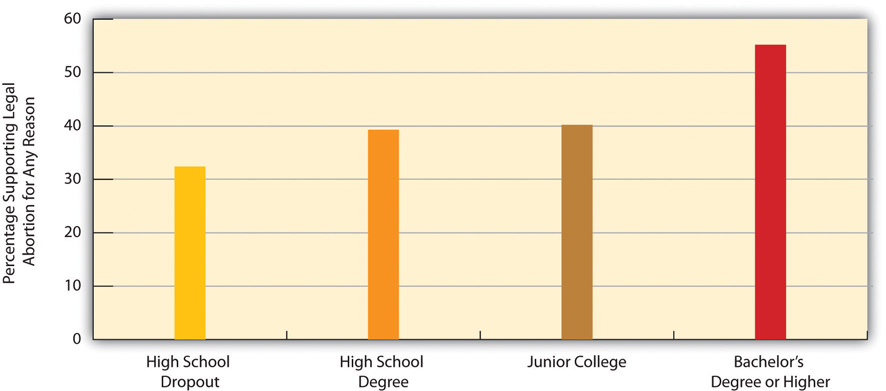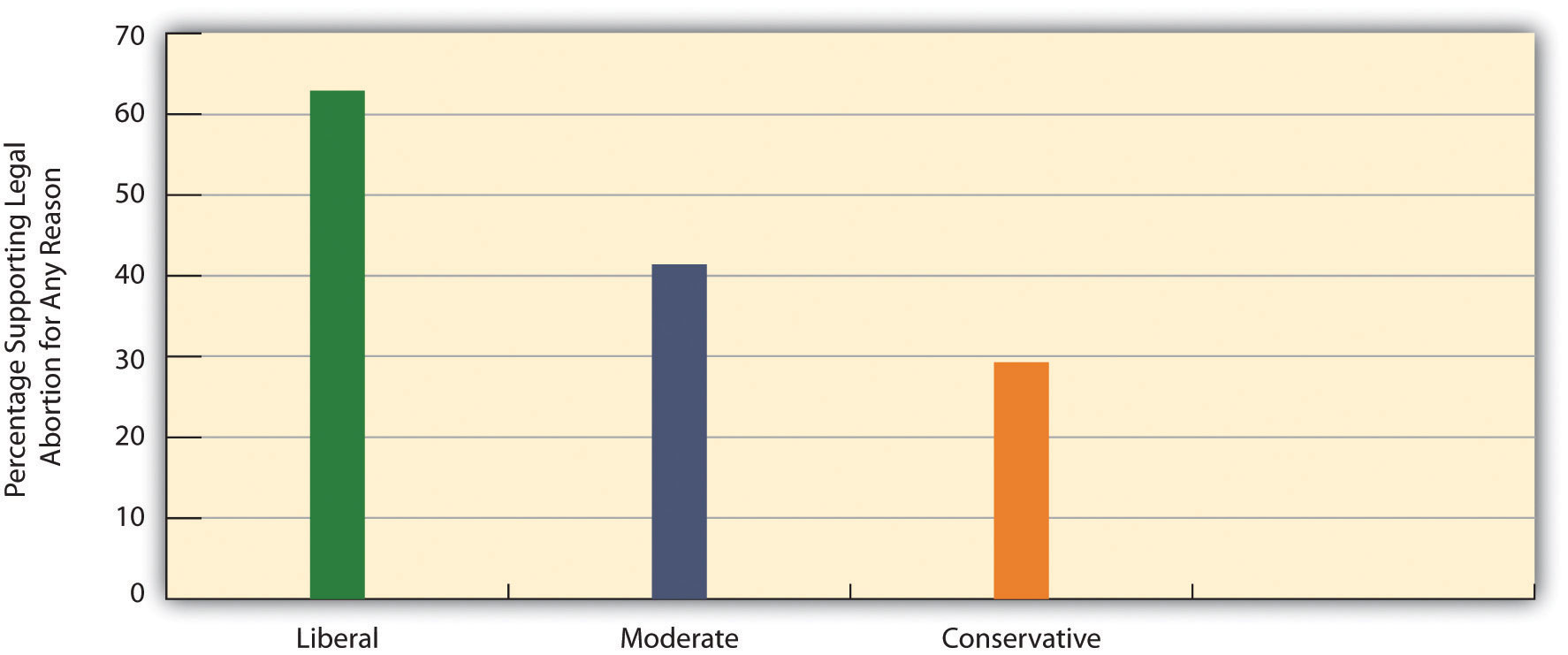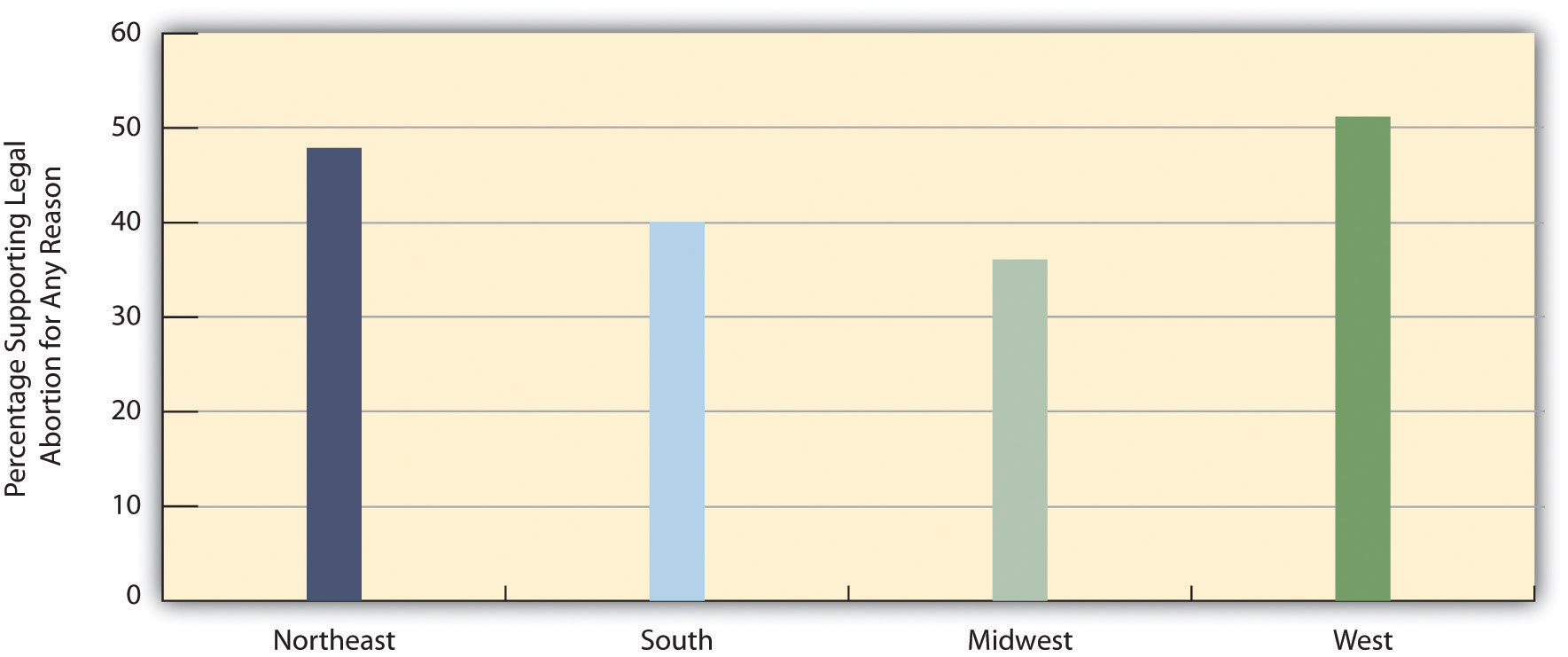9.3 Abortion
Learning Objectives
- Summarize the history of abortion and abortion law in the United States.
- Explain why there are regional differences in abortion rates.
- Describe some of the correlates of views on abortion.
A major consequence of unplanned pregnancy, during or after the teen years, is abortion. As noted earlier, about 40 percent of all unplanned pregnancies are terminated by an abortion. The more we can reduce unplanned pregnancies through the various strategies just discussed, the fewer abortions we will have. This section presents some additional information on abortion while acknowledging the incredibly strong passions that abortion raises on both sides of the issue. Many people believe that abortion represents a woman’s right to control her own body, while many other people believe that abortion is murder. We will not review these arguments, which should be very familiar by now, but we will look at the history of abortion and present some public opinion data about abortion and public health data on its prevalence. We end with a brief discussion of abortion policy.
A Brief History of Abortion
Like drug use discussed in Chapter 7 “Alcohol and Other Drugs” and prostitution discussed later in this chapter, abortion has a very long history. In fact, sex historians Vern Bullough and Bonnie Bullough (1977, p. 92) note that abortion has “been widely practiced since the beginning of recorded history.” Although early Christianity regarded abortion as murder, there was no general agreement regarding how old the fetus must be for an abortion to be considered murder. During the Middle Ages, most religious scholars thought abortion was not murder unless quickening (when a woman begins to feel the fetus moving) had occurred, which is usually about four to five months into a pregnancy. In a notable development, Pope Pius IX declared in 1869 that abortion was murder no matter how young the fetus was, and that remains the current belief of the Catholic Church.
During the nineteenth century, many countries passed new laws that banned abortion, and most US states did so as well. Bullough and Bullough (1977, p. 111) say that these new laws were intended to protect pregnant women from unskilled abortionists, but that the laws backfired because “desperate women turned to illegal practitioners.” Many illegal abortion providers were simply unskilled to perform abortions, but even doctors and midwives who provided abortions illegally did not have access to hospitals or medical clinics if something went wrong. After antibiotics came into use during the twentieth century, illegal abortion providers also did not have access to these miracle drugs and thus could not treat infections that occurred after they performed their abortions. By the early 1960s, the only legal abortions in most states were those done to save the mother’s life, with about 8,000 such therapeutic abortions performed annually.
In addition to these legal abortions, an estimated 400,000–650,000 illegal abortions were also being performed annually by the early 1960s. For the reasons just given, these abortions were often risky procedures and resulted in a “very high maternal mortality rate” (Bullough & Bullough, 1977, p. 112). In plain English, many women died from illegal abortions.
The sheer number of illegal abortions and maternal death and health complications helped ignite a new abortion rights movement. This movement also believed that women have the right to control their own bodies without government interference. By 1970, sixteen states had legalized abortion or had made abortions easier to receive under certain circumstances. Some courts began to rule that laws against abortion violated women’s constitutional right to privacy. Finally, the US Supreme Court supported legal abortion in its famous and controversial 1973 decision, Roe v. Wade. This decision allowed all abortions during the first trimester (a roughly three-month period of pregnancy) and permitted states to regulate abortion during the second trimester to protect the mother’s health, but states could still not prohibit abortion during this trimester. For the remaining trimester, states were allowed to prohibit abortion except when the mother’s life or health was at stake.
The legalization of abortion by the Roe decision was controversial from the beginning and remains controversial today (see Note 9.14 “Applying Social Research”). Amid all this controversy, it is important to keep in mind that the Roe decision protected the health and lives of many pregnant women. As the Guttmacher Institute (Cohen, 2009, p. 2) explains, “The United States legalized abortion nationwide in 1973, in part because of the clear evidence that restrictive laws were not ending abortion but were exacting a significant public health toll, notably on lower-income women who could not travel or pay for safe services. Almost immediately afterward, pregnancy-related deaths and hospitalizations due to complications of unsafe abortion effectively ended. The United States was not the first country and has been far from the last to recognize this relationship and move to liberalize its law.”
Applying Social Research
The Abortion and Crime Rate Controversy
In 2001, two scholars published an article on abortion and crime rates. The article concluded that the legalization of abortion after the Supreme Court’s Roe v. Wade decision in 1973 lowered the crime rate two decades later. They reasoned that the Roe decision increased the number of abortions among poor teenagers, whose children are at risk for delinquency and crime when they reach adolescence and young adulthood. Because the increased number of abortions meant that these children were never born, the crime rate in the late 1980s and 1990s was lower than it would have been because of the Roe decision.
This article set off a firestorm of controversy, with people on both sides of the abortion debate appalled at the implication that abortions should be promoted to lower the crime rate many years later. The article also set off a wave of social science research to determine the validity of the article’s conclusion.
The research that has been published in the decade since this controversial article has yielded mixed results. Some studies have found that legal abortion did lower the crime rate; other studies have found that it did not lower the crime rate; and some studies have even found that it raised the crime rate. Even if abortion might have lowered the crime rate during the 1990s, most criminologists think that the crime rate decline during that decade mostly stemmed from other reasons, including more effective policing and a thriving economy.
It remains highly debatable whether any possible crime-reducing effect of abortion is a relevant factor for the debate over legal abortion. Regardless of its possible relevance, however, the social science research on this issue is so equivocal that it is premature to assume that abortion does, in fact, lower the crime rate.
Sources: Chamlin, Myer, & Sanders, 2008; Donohue & Levitt, 2001; Kahane, Paton, & Simmons, 2008
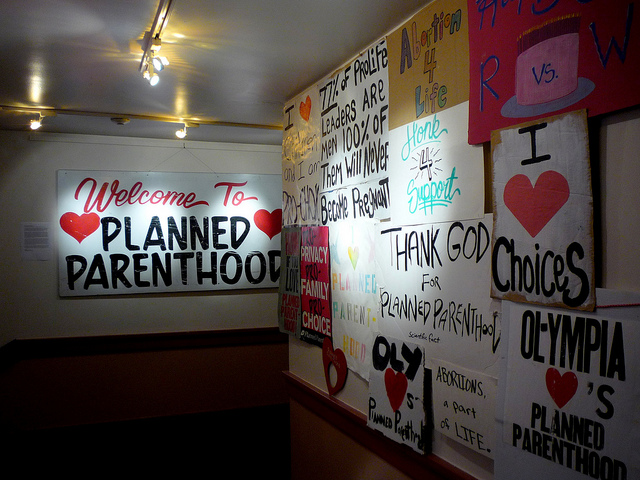
The legalization of abortion in the United States after the 1973 Roe v. Wade decision of the Supreme Court reduced the number of unsafe abortions.
Jason Taellious – Support Planned Parenthood Sign Art – CC BY-SA 2.0.
Despite the fact that Roe v. Wade ended the health risks of unsafe abortions, access to abortion has weakened in the years since this case was decided in 1973. In a 1992 ruling, Planned Parenthood v. Casey, the Supreme Court weakened Roe by ruling that states could ban abortions after the fetus became viable at twenty-two or twenty-three weeks, which is before the end of the second trimester. This ruling also allowed states to require a twenty-four-hour waiting period, the signing of an informed consent form, and the signing of a parental consent form for minors. Various acts by Congress have also made it more difficult to receive an abortion. In particular, Congressional legislation in 1976 banned Medicaid funding of abortions.
Many states have passed various measures to make it more difficult for a woman to get an abortion. As of March 2012, these selected measures were in effect (Guttmacher Institute, 2012):
- Thirty-two states prohibit the use of state funds for abortions unless the woman’s life is in danger or the pregnancy resulted from rape or incest.
- Nineteen states require that a woman receive counseling before an abortion that includes information on one or more of the following topics: the ability of a fetus to feel pain, mental health consequences following an abortion, the availability of ultrasound, or the claimed link between abortion and breast cancer.
- Twenty-six states require a waiting period between receiving counseling and receiving an abortion.
- Twenty-six states require consent from one or both parents for a minor to receive an abortion, and fifteen states require that one or both parents be notified; included in these numbers are four states that require both consent and notification.
- Two states require a woman to have an ultrasound before having an abortion.
Abortion Data
Some basic facts about the number of abortions in the United States are essential for a complete understanding of the abortion issue. (Data are for 2008 and come from Jones & Kooistra, 2011). Perhaps the most important fact is that about 1.2 million abortions occur annually in the United States, down from a peak of 1.6 million abortions in 1990. This decrease is thought to stem from a drop in unwanted pregnancies (see earlier discussion) and from a decline in facilities that provide abortions because of harassment from abortion opponents and reduced public funding. About 90 percent of abortions are done during the first trimester (approximately twelve weeks).
The abortion rate (number of abortions per 1,000 women ages 15–44) differs by region (2008 data) and is highest in the Northeast and lowest in the Midwest (see Figure 9.8 “Regional Differences in Abortion Rates, 2008”). It should be noted, however, that there is much variation within each region. In the West, for example, the abortion rate is 27.6 in California but only 0.9 in Wyoming.
Figure 9.8 Regional Differences in Abortion Rates, 2008
Source: Data from Jones, R. K., & Kooistra, K. (2011). Abortion incidence and access to services in the United States, 2008. Perspectives on Sexual and Reproductive Health, 43, 41–50.
These regional and state differences greatly reflect the presence or absence of nearby abortion providers. In many parts of the nation, it is very difficult and even practically impossible for women to get an abortion. Only 13 percent of the more than 3,000 counties in the United States have an abortion provider; one-third of women of childbearing age (15–44) live in the 87 percent of counties that lack any abortion providers (Jones & Kooistra, 2011). These women must travel relatively long distances to a provider and may lack the money or transportation to do so. The percentage of women ages 15–44 in counties with no provider reflects the regional abortion rates in Figure 9.8 “Regional Differences in Abortion Rates, 2008”. In the Midwest, 52 percent of these women live in counties without a provider. Comparable figures for the other regions are: Northeast, 18 percent; South, 47 percent; and West, 13 percent. About half of all women in the Midwest and South, then, live in counties without an abortion provider.
Public Views about Abortion
People tend to hold very strong views about abortion, and the news media regularly report on rallies and other events carried out by both sides of the abortion controversy. This news coverage obscures an important fact about public opinion on abortion: The public largely supports abortions that occur under certain circumstances, while it is divided over abortions that occur under other circumstances. On some types of abortions, then, there is a strong public consensus in a favor of abortion, while on other types of abortions there is much disagreement.
The circumstances for which the public largely supports abortions are those where the physical health of the mother is at stake, where the pregnancy resulted from a rape or act of incest, or where the baby is likely to have a serious defect. The circumstances for which the public is divided on abortion are those where a woman wants an abortion for any other reason, including her wish not to have any more children.
We see evidence of these two patterns of abortion opinion in data from the GSS. The GSS regularly asks a series of questions that begin with the following statement: “Please tell me whether or not you think it should be possible for a pregnant woman to obtain a legal abortion if…” After this initial statement, the question lists a circumstance or reason for an abortion. These scenarios are as follows: (a) The woman’s own health is seriously endangered by the pregnancy; (b) she became pregnant as a result of rape; (c) there is a strong chance of serious defect in the baby; (d) she is married and does not want any more children; (e) the family has a very low income and cannot afford any more children; (f) she is not married and does not want to marry the man; and (g) the woman wants it for any reason.
As Figure 9.9 “Support for Legal Abortion (Percentage Saying a Woman Should Be Able to Obtain a Legal Abortion for Each Circumstance)” shows, strong majorities of the public support a legal abortion for the first three scenarios: the women’s health is endangered, the pregnancy resulted from a rape; or the baby is likely to have a serious defect. On the other hand, only 40–50 percent of the public support a legal abortion for the remaining scenarios: a married woman does not want more children, the family cannot afford more children, an unmarried woman does not want to marry; or a woman wants an abortion for any reason.
Figure 9.9 Support for Legal Abortion (Percentage Saying a Woman Should Be Able to Obtain a Legal Abortion for Each Circumstance)
Source: Data from General Social Survey. (2010). Retrieved from http://sda.berkeley.edu/cgi-bin/hsda?harcsda+gss10.
Correlates of Public Views

Although the Catholic Church is a leading opponent of legal abortions, Catholics are not more likely than Protestants to oppose legal abortion.
Matthew Paulson – Sacred Heart Catholic Church – CC BY-NC-ND 2.0.
Reflecting the sociological principle that our social backgrounds influence our attitudes and behaviors, several aspects of people’s social backgrounds are associated with their views on abortion. We can illustrate this by using the GSS question that asks whether respondents support a legal abortion “for any reason.” In the entire GSS sample, about 43 percent support legal abortion for any reason; using a common term for people who favor legal abortion, they are entirely pro-choice.
You have probably heard many times that people who are religious tend to oppose abortion rights much more than people who are less religious. Using the GSS “for any reason” item, we would thus expect that very religious people would be much less likely than other people to favor abortion for any reason. Figure 9.10 “Self-Rated Religiosity and Support for Legal Abortion for Any Reason (%)” shows this is indeed the case. People who say they are not religious are almost four times more likely than those who are very religious to support a legal abortion for any reason.
Figure 9.10 Self-Rated Religiosity and Support for Legal Abortion for Any Reason (%)
Source: Data from General Social Survey. (2010). Retrieved from http://sda.berkeley.edu/cgi-bin/hsda?harcsda+gss10.
You have probably also heard many times that the Catholic Church is a leading opponent of legal abortion. Does this mean that Catholics themselves are less likely than Protestants to support legal abortion for any reason? The answer to this question is no: Figure 9.11 “Religious Preference and Support for Legal Abortion for Any Reason (%)” shows that Catholics and Protestants are about equally likely to favor legal abortion for any reason, with Jews and people with no religious preference about twice as likely to favor it.
Figure 9.11 Religious Preference and Support for Legal Abortion for Any Reason (%)
Source: Data from General Social Surveys. (2008–2010). Retrieved from http://sda.berkeley.edu/cgi-bin/hsda?harcsda+gss10.
It might make sense to think that women are more likely than men to favor legal abortion. However, there is no gender difference in this regard. As Figure 9.12 “Gender and Support for Legal Abortion for Any Reason (%)” shows, women are in fact slightly less likely than men to favor legal abortion, although the difference shown in the figure is too small to be statistically significant.
Figure 9.12 Gender and Support for Legal Abortion for Any Reason (%)
Source: Data from General Social Survey. (2010). Retrieved from http://sda.berkeley.edu/cgi-bin/hsda?harcsda+gss10.
Three other aspects of our social backgrounds are rather strongly associated with abortion views: education, our political views, and region of country. People with college degrees are much more likely than those with lower education levels to support legal abortion for any reason (Figure 9.13 “Education and Support for Legal Abortion for Any Reason (%)”); liberals are twice as likely as conservatives to favor legal abortion (Figure 9.14 “Self-Described Political Views and Support for Legal Abortion for Any Reason (%)”); and people in the Northeast and West are more likely to favor legal abortion than people in the South and Midwest.
Figure 9.13 Education and Support for Legal Abortion for Any Reason (%)
Source: Data from General Social Survey. (2010). Retrieved from http://sda.berkeley.edu/cgi-bin/hsda?harcsda+gss10.
Figure 9.14 Self-Described Political Views and Support for Legal Abortion for Any Reason (%)
Source: Data from General Social Survey. (2010). Retrieved from http://sda.berkeley.edu/cgi-bin/hsda?harcsda+gss10.
Figure 9.15 Region and Support for Legal Abortion for Any Reason (%)
Source: Data from General Social Survey. (2010). Retrieved from http://sda.berkeley.edu/cgi-bin/hsda?harcsda+gss10.
Reducing Abortions and Making Them Safe
No one likes abortions. Abortion rights opponents liken them to murder, and abortion rights proponents are certainly not gleeful when abortions occur. Rather, they recognize that abortions will occur whether they are legal or illegal, and they think that legal abortion protects women from the dangers of illegal abortions and recognizes women’s right to control their own bodies. As President Bill Clinton and Secretary of State Hillary Clinton have summarized the view of abortion rights proponents in various speeches during the past two decades, abortion should be safe, legal, and rare.
Chapter 7 “Alcohol and Other Drugs”’s discussion of illegal drugs emphasized that “what’s past is prologue”: Because drugs have been used since prehistoric times, it is no surprise that illegal drug use remains common today even despite possible arrest and punishment. The long history of abortion suggests that “what’s past is prologue” is again a relevant theme for this particular behavior. Since the beginning of recorded history, women have tried to end their pregnancies. Whatever we might think of abortion, the fact remains that many women will continue to try to end their pregnancies whether abortion is legal or whether it is illegal. As with teenage pregnancy and the use of illegal drugs, a harm reduction approach to abortion again makes sense in view of this basic fact, as we shall now explain.
Around the world, the rate of abortion is generally unrelated to whether it is legal or illegal. Laws against abortions thus do not reduce abortions, but they do cause another very serious problem (Barot, 2011). When abortion is illegal, women either must have an abortion from an unskilled provider in unhygienic conditions, or they may try to induce their own abortion by inserting an object into their uterus or by ingesting a toxic substance. Not surprisingly, all these illegal abortions are very risky and can lead to many complications, including severe bleeding, serious infection, or organ damage, any of which can be fatal. Unsafe abortion around the world is one of the top three reasons for maternal mortality, along with childbirth-related infection and hemorrhaging. For abortion to be safe, then, it must be legal. Making abortion illegal does not make abortions disappear, but it does make them dangerous.
Both sides of the abortion debate want to see abortions reduced. How then can this goal be achieved? The most promising strategy is to reduce unintended pregnancies, as discussed in the previous section on teenage pregnancy, through the consistent use of effective contraception. The reason for this strategy is simple: Almost all abortions result from unintended pregnancies, and if we can reduce unintended pregnancies, we will reduce the number of abortions. As the Guttmacher Institute (Barot, 2011, p. 24) explains, “Extensive research shows that behind almost every abortion is an unintended pregnancy, and the most effective way to prevent unintended pregnancy is through correct and consistent use of contraceptives.”
Ironically, the religious opponents and politically conservative opponents of abortion also tend to be opposed to sex education that emphasizes safe sex and, as well, to providing contraceptives at no cost or low cost to sexually active teenagers and young adults. During the past few years, many state governments led by conservative governors and/or state legislatures have reduced or eliminated funding for Planned Parenthood and other family planning agencies whose clients are largely low-income women (Pollitt, 2011; Tan, 2011).
These funding cuts and other efforts to reduce contraceptive counseling and provision have two consequences. First, they help ensure that many more unwanted babies are born, at a cost of roughly $10,000 in medical delivery costs for each baby and thousands of dollars more in the societal problems (discussed in the teenage pregnancy section) associated with unwanted births to poor mothers. In 2011, Texas reduced family planning funds by $73 million annually, despite estimates that this reduction would result in 20,000 additional births annually that would involve $200 million in medical delivery costs.

Efforts to reduce contraceptive counseling and the use of contraceptives help increase the number of unplanned pregnancies and, in turn, the number of abortions.
anqa – contraceptive pills – CC BY-NC 2.0.
Second, these efforts also help ensure that more unintended pregnancies and thus more abortions will occur. If, as the Guttmacher Institute reminds us, almost all abortions result from unintended pregnancies, then any efforts by political and religious forces that make it less likely that sexually active people use contraception ironically help increase the number of abortions. Because abortion opponents want to reduce abortions, they should favor additional funding for family planning agencies and for other efforts that increase contraceptive use.
A few numbers indicate the seriousness of the problem. The federal program that funds family planning centers is Title X of the Public Health Services Act. Centers funded by Title X provide contraceptive services and other services to about 4.7 million women annually. The Guttmacher Institute (2011) estimates that these services help prevent 973,000 unintended pregnancies. These pregnancies would have resulted in 433,000 unplanned births and 406,000 abortions. If efforts that have been attempted in Congress to reduce or eliminate Title X funding succeed, these pregnancies and abortions would occur.
Beyond these considerations, it is also important that public funds be available to pay for abortions by low-income women. As noted earlier, Medicaid funding cannot be used for abortions that are not meant to protect the mother’s health or to end a pregnancy from rape or incest, and about two-thirds of the states have eliminated state funding for these abortions. Because only a small proportion of women are poor enough to be covered by Medicaid, restoring Medicaid coverage for all abortions would increase the number of abortions by only 2.5 percent (Gold, 2010).
Although people on both sides of the abortion debate have sincere, strongly held views, a dispassionate analysis based on the discussion in this section leads to the following conclusions. First, if we want abortions to be rare, efforts to promote safe sex and the consistent use of effective contraception must be applauded and funded, not condemned and unfunded. Second, abortions will occur whether or not they are legal; recognizing this fact, if we want abortions to be safe, they must be legal, and restrictions on access to them should be removed.
Key Takeaways
- Abortion continues to be one of the most controversial issues in the United States. Many states have implemented laws and policies that make it difficult to obtain abortions.
- Several aspects of our social backgrounds predict views on legal abortion. In particular, religiosity is associated with opposition to legal abortion, while education is associated with approval of legal abortion.
- To reduce the number of abortions, it is necessary to reduce unwanted pregnancies. To ensure that abortions will be safe, they must be legal.
For Your Review
- Do you favor or oppose legal abortion? Does your answer depend on the reasons for which a woman desires an abortion? Write an essay in which you explain your answer.
- A major principle of sociology is that social backgrounds influence attitudes and behavior. Write an essay in which you illustrate this principle with regard to attitudes about abortion.
References
Barot, S. (2011). Unsafe abortion: The missing link in global efforts to improve maternal health. Guttmacher Policy Review, 14(2), 24–28.
Bullough, V. L., & Bullough, B. (1977). Sin, sickness, and sanity: A history of sexual attitudes. New York, NY: New American Library.
Chamlin, M. B., Myer, A. J., & Sanders, B. A. (2008). Abortion as crime control: A cautionary tale. Criminal Justice Policy Review, 19(2), 135–152.
Cohen, S. A. (2009). Facts and consequences: Legality, incidence and safety of abortion worldwide. Guttmacher Policy Review, 12(4), 2–6.
Donohue, J. J., & Levitt, S. D. (2001). The impact of legalized abortion on crime. Quarterly Journal of Economics, 116, 379–420.
Gold, R. B. (2010). Insurance coverage and abortion incidence: Information and misinformation. Guttmacher Policy Review, 13(4), 7–10.
Guttmacher Institute. (2012). An overview of abortion laws. Retrieved on March 31, 2012 at http://www.guttmacher.org/statecenter/spibs/spib_OAL.pdf.
Guttmacher Institute. (2011). Title X-supported family planning services nationally and in each state. Retrieved November 4, 2011, from http://www.guttmacher.org/media/inthenews/2011/02/16/index.html.
Jones, R. K., & Kooistra, K. (2011). Abortion incidence and access to services in the United States, 2008. Perspectives on Sexual and Reproductive Health, 43, 41–50.
Kahane, L. H., Paton, D., & Simmons, R. (2008). The abortion-crime link: Evidence from England and Wales. Economica, 75(1), 1–21.
Pollitt, K. (2011, October 5). Ban birth control? They wouldn’t dare… The Nation. Retrieved from http://www.thenation.com/article/163808/ban-birth-control-they-wouldnt-dare?rel=emailNation.
Tan, T. (2011, October 16). Planned Parenthood struggles after state budget cuts. New York Times, p. A29.

